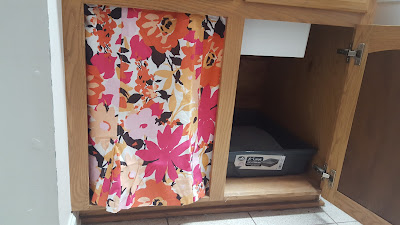I'm eliminating clutter from our home using the KonMari method. I learned about it in the book, "The Life-changing Magic of Tidying Up" by Marie Kondo. It may sound cliche, but it really is life-changing.
Recently, my BFF and I ripped out all of the built-in shelving from my master closet. The spacing was impractical and they weren't adjustable. We got a little aggressive with the hammer, so last weekend I patched, sanded and repainted the closet walls.
 |
| Emptying the closet |
 |
| Shelves ripped out. Walls full of dents. |
 |
| Walls patched and painted |
Then, my husband hung ClosetMaid Shelftrack tracks, screwing them into the wall headers. The standards hang from the track. You can reconfigure them as your needs change over time with no unsightly holes to patch. The SuperSlide brackets let you slide hangers continuously along the rod.
I have two armoires that I bought second hand. They are solid wood, Bassett pieces that I got for $150 total. No particle board or cardboard backing here. The style is a bit dated, but they provide dust-free storage.
Since my husband is 6' 2", I decided it would be more convenient for him to reach into an armoire than bend over to retrieve clothes from dresser drawers. So I decided to move the armoires into the closet.
Before I could move his clothes in, I needed a way to contain them on the shelves. One of Marie's methods is to fold most clothing, rather than hanging it. And, by folding it so that each piece stands on its own, you can store more items in a smaller space. Standing the items up like fabric soldiers also means nothing is hidden from view.
I searched online for storage solutions that were both practical and affordable. When I found nothing, I turned to Pinterest for some DIY inspiration. Basically, what I needed was a really big organizer tray. So, I picked up a few supplies to add to what I already had on hand and got to work.
Supplies:
foam core board (I bought a tri-fold project board)
Elmers Glue All or other PVA glue
craft knife with a fresh blade
cutting mat
pencil (I used a chalk pencil on the black board)
straight edge
tape for trimming the edges
- Determine the measurements for your finished product then deduct 1/2 inch from the length and width to allow for the thickness of the foam core board. Cut a piece of foam core board to these dimensions. This will be the base.
- Cut two pieces to the exact length of the short sides by 3" tall.
- Add 1/2" to the measurement of the long sides and cut two pieces this length by 3" tall.
- Run a thin bead of glue along one short side and butt a short piece to it. Secure it in place with straight pins. Then do the same to the other short side.
- Add a long side, which should cover the raw edges of the short sides because you added the extra length. Secure with pins. Do the same to the other side.
- If you want to add dividers, measure inside the assembled tray and cut to fit. glue in place. If you want to add decorative fabric or paper to the inside base, do it before adding the dividers.
- Once the glue has dried a about 20 minutes or so, you can remove the pins and begin trimming with tape.
- Cut a strip of tape to length and center it over the raw edge of one end. Trim the ends of the tape as needed then smooth it down onto the board, making sure not to press too hard, which will leave indentations in the board.
- Do this for the top edges, the bottom edges, then the corners. Or you may want to do the corners first, it's up to you.
- Add additional decorative trim if you wish.
And this is how it looks in the armoire. Pretty cool, huh?
I used black board and black tape to keep it simple. I could add a wide ribbon trim to the front or decorative knobs, even. There are lots of different decorative tapes that you can use to make your tray fun and functional. You could cover the inside with decorative paper or leave the tape off and use spray adhesive to cover the entire tray with fabric.
Scale the tray down a bit and it becomes a drawer organizer. Scale it down even more, and it's a jewelry or make-up organizer. The uses are endless.
I hope you find this DIY helpful. Please leave comments and photos if you make one for yourself.


















